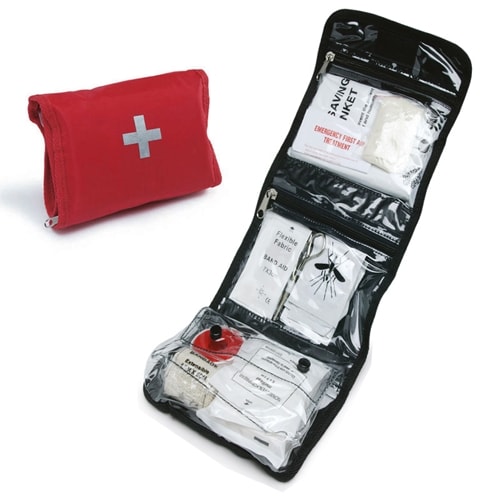Injuries and illness are an unfortunate part of horse care. But being prepared to give your horse first aid could make a big difference in the outcome of the situation. Every horse owner needs basic first-aid essentials. In such circumstances, before putting any of these tools to use, contact a veterinarian so they can assess the situation.
Keep these useful horse supplies on hand while waiting for the vet to arrive:
- Bandages: Protect wounds, provide support to muscles and hold ice packs with horse leg wraps or self-adhesive bandages. An assortment of bandaging materials are helpful to have on hand. Add the following to your first aid kit: cotton padding and nonstick gauze, duct tape and disposable diapers, sterile gauze and elastoplast, white adhesive medical tape, plastic wrap and cotton leg wraps.
- Buckets: Soak hooves and clean wounds with buckets kept specifically for first aid use.
- Diluted iodine: Any scrapes, cuts or puncture wounds can be flushed out with diluted iodine and covered to keep them from drying until the vet comes to treat them.
- Electrolytes: Prevent dehydration by having an Electrocharge™ on hand. Electrocharge™ is a concentrated blend of electrolytes and trace mineral salts that helps promote healthy hydration in horses.
- Flashlight: At nighttime or early morning, a flashlight might be necessary to assess the problem.
- Fly repellant: Keep flies away from an open wound that can’t be covered with a bandage. Be sure to apply repellent around the wound, not directly on it.
- Hemostat: Hemostats are meant to remove splinters, burrs and thistles from a horse’s skin.
- Hoof pick: Remove foreign objects from hooves and shoes with a hoof pick. Additionally, regular use of a pick helps keep the hooves healthy by removing objects or dirt clumps that can make walking uncomfortable and even painful for a horse.
- Ice pack: Ice packs will help reduce swelling.
- PVC Pipes: Cut 6-inch -diameter piping in half lengthwise and then into 1.5- to 2-foot sections for use as an emergency splint.
- Rubbing alcohol: Use this to disinfect thermometers, scissors and other horse supplies.
- Scissors or knife: It’s a good idea to keep something for cutting bandaging materials or freeing a horse caught in a rope. Always exercise caution when using scissors around your horse.
- Stethoscope: A horse’s heartbeat can be heard the loudest behind its left elbow. The normal heart rate for a horse is 25-45 beats per minute. Ponies may have a slightly faster normal heart rate. A stethoscope is also useful for listening to gut sounds. This is a must-have for any barn.
- Surgical gloves: These will help owners keep their hands clean and prevent wound contamination.
- Thermometer: If the horse looks sick, keeping a thermometer on hand allows owners to assess if the horse has a normal temperature. Normal horse temperature is between 99 and 101.5 degrees Fahrenheit. Note: Taking a horse’s temperature routinely when it is healthy will help determine what is normal for the horse.
- Wire cutter: Use this item to free your horse from fences.
- Wound antiseptic: Prevent infections with a sulfur antiseptic powder, ointment or Fura-Free™. In addition, it’s not a bad idea for owners to keep tampons available to stop the bleeding in puncture wounds.
After any incident, horse owners should see their vet immediately.
Fura-Free™ is a safe sweat and salve that helps promote healthy skin, and it’s Nitrofurazone free. Fura-Free™ protects and soothes minor cuts, scrapes, burns and cracked heels.








